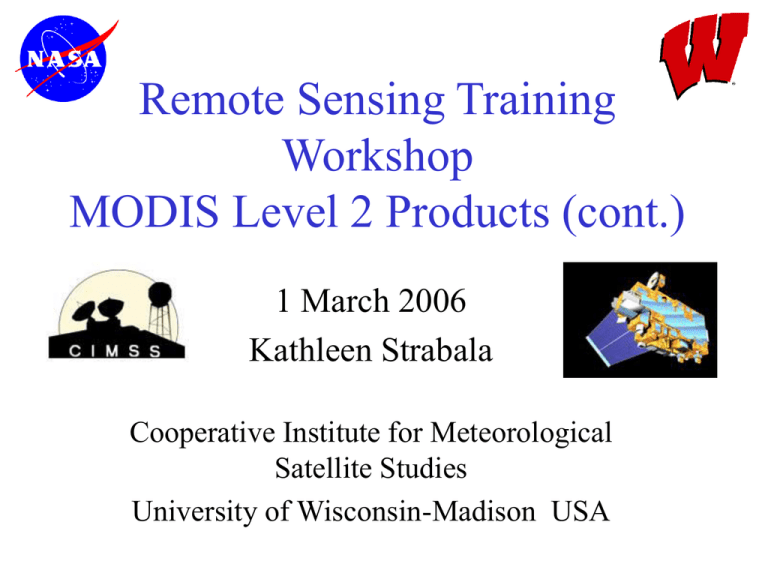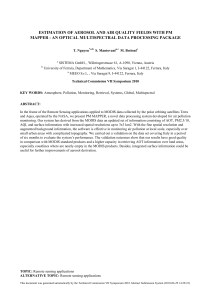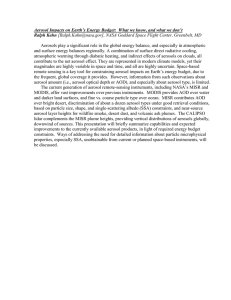Remote Sensing Training Workshop MODIS Level 2 Products (cont.) 1 March 2006
advertisement

Remote Sensing Training Workshop MODIS Level 2 Products (cont.) 1 March 2006 Kathleen Strabala Cooperative Institute for Meteorological Satellite Studies University of Wisconsin-Madison USA Viewing Atmospheric Aerosols From the MODIS Satellite Sensor Lorraine A. Remer NASA/Goddard Space Flight Center And the MODIS aerosol team: Y.J. Kaufman, D. Tanré D.A. Chu, C. Ichoku, R. Kleidman, I. Koren, R. Levy, R-R. Li, J.V. Martins, S. Mattoo Theory Deriving aerosol over land. Problem: Land surface variability. At the satellite, how do we separate signal originating from the atmosphere containing information about the aerosol from signal originating from the land surface? Scattering and Absorption of Light by Aerosols Io=Light Source (W/m2) L=Path Length I=Light Detector (W/m2) I ( sp a p ) L ext L e e I0 ( sp ap ) * L sp /( sp ap ) The quantity L is called the density weighted path length. ext() L is a measure of the cumulative depletion that the beam of radiation has experienced as a result of its passage through the layer and is often called the optical depth . Getting A Best Fit for the Observations Match Theory and Observations Aerosol reflectance 0.01 0.001 dry s moke r urban r wet r salt r dust r dust r ef f ef f ef f ef f =0.10 µm =0.20 µm =0.25 µm =1 µm ef f ef f =1 µm =2.5 µm 0.0001 0.4 0.5 0.6 0.8 1 wavelength (µm) 2 Wide Spectral Range makes land retrieval possible (µm) (µm) • Mid-IR is used to observe the surface brightness • Then aerosol is derived from estimated surface reflectance in the visible and actual reflectance 0.66 ~ [r*0.66 0.5r*2.1 ] 0.47 ~ [r*0.47 0.25r*2.1 ] 1.2 1.2 1.6 1.6 2.1 2.1 0.47 0.47 0.55 0.55 0.66 0.66 Yoram Kaufman 3 non-dust models plus dust Set by geography and season Models are dynamic f() Urban/Industrial(0.96) Highly Absorbing (0.85) “smoke”- moderate absorption (0.90) Highly absorbing (0.85) Seasonally moderate (0.90) Highly absorbing (0.85) Seasonally urban/industrial (0.96) The Ocean Algorithm Choice of 4 fine modes and 5 coarse modes In order to minimize (rmeas - rLUT) over 6 wavelengths Aerosol reflectance 0.01 And 5 coarse modes 0.001 dry s moke r urban r wet r salt r dust r dust r ef f ef f ef f ef f =0.10 µm =0.20 µm =0.25 µm =1 µm ef f ef f =1 µm =2.5 µm 0.0001 0.4 0.5 0.6 0.8 1 wavelength (µm) 2 MODIS Over Land Algorithm 20 x 20 pixels at 500 m resolution (10 km at nadir) 400 total - 56 water ________ 344 - 24 snow ________ water snow cloud 320 - 55 cloud _______ 265 -116 “bright” ________ cloud 149 “good” Discard brightest 50% and darkest 20% of the 149 good pixels. 10 km 44 pixels Non-static Inputs • MODIS L1B (MOD021KM, MOD02HKM, MOD02QKM) and geolocation file (MOD03) • MODIS Cloud Mask (MOD35) • 6 hourly Global Data Assimilation System T126 resolution analysis from NCEP (Land Surface Temperature) Water vapor information (not mandatory) ex: gdas1.PGrbF00.020430.00z • Daily TOVS and SBUV/2 Total Ozone from NESDIS 1 x 1 degree resolution (not mandatory) ex: TOAST16_050615.GRB • Latest 7 days ancillary data and documentation available from: Output Product Description MOD04 Key Output Parameters 10x10 pixel (1km) resolution • Optical_Depth_Land_And_Ocean – Aerosol Optical Thickness (AOT) at 0.55 microns for both ocean (best) and land (corrected) • Optical_Depth_Ratio_Small_Land_And_Ocea n - Ratio of small mode optical depth to total at 0.55 microns • Corrected_Optical_Depth_Land (3 bands) Corrected optical thickness at 0.47, 0.55, and 0.66 microns • Effective_Optical_Depth_Average_Ocean (7 bands) - AOT at seven bands for average solution at .47, .55, .66, .86, 1.2, 1.6 and 2.1 Separating fine mode from coarse mode aerosol California Wildfires Oct. 26, 2003 From TerraMODIS RGB FLUX AOT Fraction fine Rong-Rong Li 0.47 µm 0.55 µm 0.87 µm 2.13 µm 1.24 µm Spectral Optical Thickness 7 wavelengths over ocean 0.66 µm 1.63 µm 3 wavelengths over land Cropped from images by Paul Hubanks Aerosol Optical Thickness The global aerosol MOD08_D3 Daily Level 3 1 degree data Fine mode fraction October 26, 2003 http//:modis-atmos.gsfc.nasa.gov Paul Hubanks Two MODIS instruments. Terra (10:30 am local time) and Aqua (1:30pm local time) May 1st, 2003. The dust storm moved 120 kms between the Terra and Aqua observations, corresponding to wind speed in the dust layer of 11m/s. Ilan Koren and Yoram Kaufman Terra MOD08_D3 Daily Level 3 aerosol optical thickness on a 1 degree global grid Aqua May 1, 2003 http//:modis-atmos.gsfc.nasa.gov Paul Hubanks MODIS Aerosol Optical Thickness Product University of Wisconsin – Madison Direct Broadcast MODIS aerosol validation 2000-2002 R = 0.92 1 100 points 50 points 25 points 15 points 0.8 MODIS AOT (660 nm) AERONET sites y = 0.008 + 0.95 x 0.6 0.4 ocean OCEAN 660 nm N = 2052 0.2 0 ocean land both 0 0.2 0.4 0.6 0.8 1 AERONET AOT (660 nm) y = 0.059 + 0.70 x R = 0.68 1 71% of MODIS aerosol retrievals over land fall within expected uncertainty 300 points 150 points 75 points 32 points 0.8 MODIS AOT (660 nm) 66% of MODIS aerosol retrievals over ocean fall within expected uncertainty 0.6 0.4 land 0.2 LAND 660 nm N = 5906 0 0 0.2 0.4 0.6 0.8 AERONET AOT (660 nm) 1 Over ocean retrievals of aerosol fine fraction Fine fraction is the fraction of AOT due to the fine mode. No filtering out of dust retrievals. A value of 0 means the aerosol is all large particles. 271 co-located points with > 0.15 A value of 1 means the aerosol is all small particles. from ~500 points for all . Monthly means plotted against each other. 62% fall with ±0.10 µm fine mode fraction of optical thickness WASHINGTON Anmyon, Korea E Asia Europe 1 Pacific Ocean 0.9 Capo Verde India S Africa 16 quadrants of the Earth more pollution 0.8 0.7 0.6 0.5 more dust 0.4 0.3 0.2 baseline oceanic aerosol 0 0.1 0.2 0.3 0.4 Aerosol optical thickness Yoram Kaufman 0.5 0.6 Summary before Applications: 1. MODIS algorithms take advantage of instrument’s wide spectral range (both land and ocean), excellent calibration (essential for size retrievals), 500 m spatial resolution (proximity to clouds). 2. MODIS products validated with AERONET and uncertainties are well-chararacterized. Known problems listed at the DAAC or at http://modis-atmos.gsfc.nasa.gov/validation.html 3. Algorithm under constant review and modification. Track history of changes at http://modis-atmos.gsfc.nasa.gov/products_history.html Applications: 1. Direct radiative forcing (different methods) 2. Indirect radiative forcing 3. Semi-direct forcing 4. Air Quality 5. Estimating biomass burning sources Aerosol direct radiative effect MODIS 2004 Aerosol Indirect Forcing from MODIS Visible (0.66, 0.55, 0.47 µm) Mid-IR (2.1, 1.6, 1.2 µm) Terra-MODIS, July 5, 2002, 16:45 UTC Fires burning in Quebec In visible… Areas brighten as smoke increases Smoke + Clouds In mid-IR… Background reflectance constant Tail elongates in light smoke area Clouds brighten as smoke increases Smaller cloud droplets No clouds in heavy smoke. Sept 9 Sept 10 4 day sequence showing transport of regional pollution event. Posts show EPA PM2.5 ground-based measuring site. Color contours are MODIS aerosol optical depth Sept 11 0.0 0.2 0.4 0.6 Aerosol Optical Depth 0.8 1.0 0 10 20 30 40 Cloud Optical Thickness 50 60 70 0 No EPA sites MODIS fills in Sept 12 15.5 40.5 65.5 PM2.5 (ug/m3) 150.5 Do MODIS total column optical thickness products correspond quantitatively to Air Quality parameters measured at the surface (PM2.5)? Time Series shows agreement of hourly PM2.5 Concentrations (Surface Monitor) and Aerosol Optical Depth in Coincident MODIS pixel. Correlation Coefficient > 0.88. J. Szykman (EPA), D.A. Chu Fires in MT/ID, Aug 2000 : Ichoku, Kaufman, Hao MODIS fire/smoke Aug. 23 2000 MODIS AOT Aug 23, 2000 MODIS Fire Temp. Aug 23, 2000 MOPITT CO Aug 22-27 MODIS burn scar Aug 23, 2000 Acknowledgements MODIS Aerosol Team: D.A. Chu, C. Ichoku, R. Kleidman, I. Koren, R. Levy, R-R. Li, J.V. Martins, S. Mattoo, Z. Ahmad AERONET: B. Holben, O. Dubovik, T. Eck, I. Slutsker, A. Smirnov AERONET PIs: (SIMBIOS) C. McLain, G. Fergion, C. Pietras MODIS Atmospheres: M. King, P. Menzel , B-C. Gao, S. Ackerman, R. Frey , M. Gray, L. Gumley, P. Hubanks, R. Hucek, E. Moody, W. Ridgway, K. Strabala MODIS Land/ Univ. of Maryland: E. Vermote NOAA/NESDIS/ORA: A. Ignatov, X. Zhao Climate and Radiation Branch (code 913): M-D. Chou, M. Suarez Atmospheric Chemistry Branch (code 916): M. Chin, P. Ginoux, O. Torres Univ. Alabama Huntsville: C. Sundar, J. Zhang





